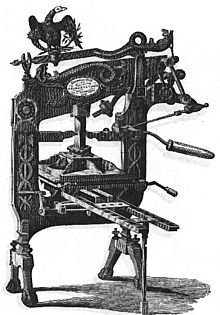Benjamin Walker as Publisher
Benjamin Walker was a Philadelphia publisher whose shop on South Fourth Street was at the center of the American book publishing world in the nineteenth century [Image 6]. Many of the most significant innovations in publishing in the young Republic took place in the book district of that city. In the first years of the 1800s, Philadelphia press builder George Clymer introduced the Columbian Press, which substituted the fulcrum for the screw as the source of impressing power and increased speed of production while reducing costs [Image 7]. By the 1820s the science of mechanics had developed sufficiently to encourage the use of cylindrical applications of power, and the river systems in the Philadelphia region were useful for generating such power. New techniques for papermaking also encouraged the use of the dense Pennsylvania woods for the purposes of book making.[11]
Despite these innovations, books were still expensive to publish and distribute, especially in the years after the Panic of 1837. Walker recognized that only certain kinds of texts could be illustrated—either deluxe volumes catering to a small, wealthy clientele or (more frequently) popular works that promised a large enough circulation to justify the time and cost of pictorial embellishment. His goal was to encourage the development of a trade in pictorial books that could sustain itself over time. To do this, Walker had to sell Americans on the value of visual literacy, had to educate them in a new way of “reading the past through pictures.”[12] He also had to convince authors and illustrators to work for reduced wages so that the costs of production would not become prohibitive.



